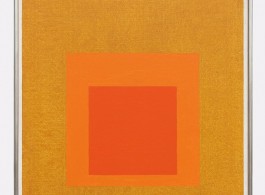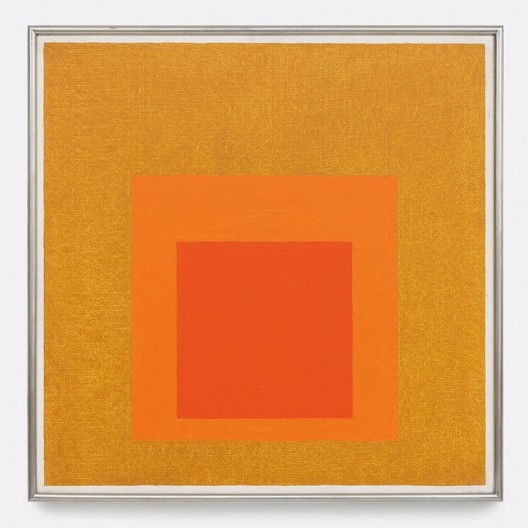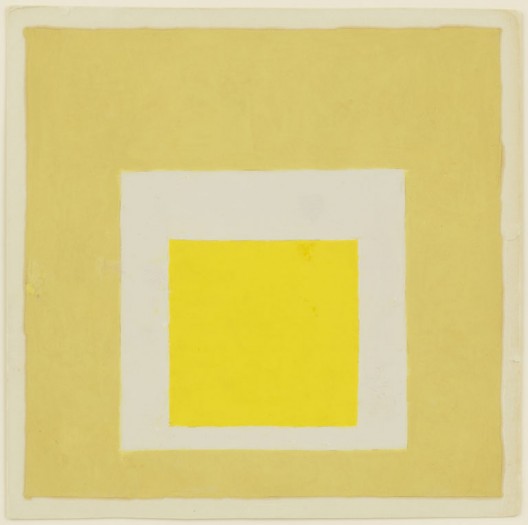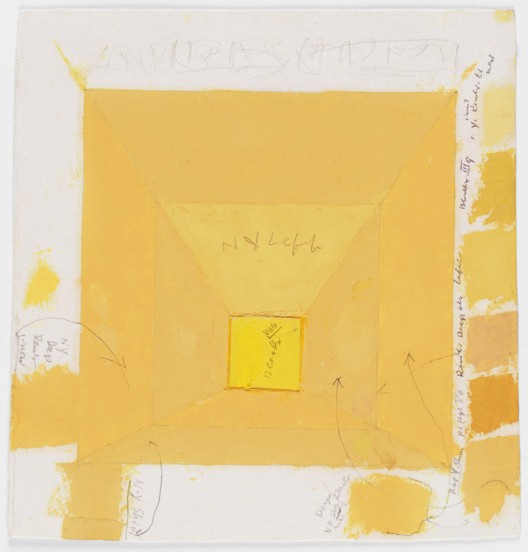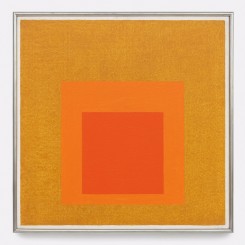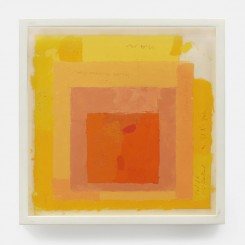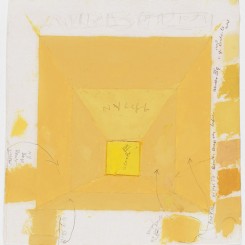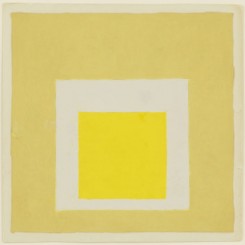“Sunny Side Up”
David Zwirner
London
In a new and unusual approach to color in the work of abstract painter Josef Albers, David Zwirner’s first London exhibition devoted to Albers focuses on one color that held a pervasive place in the artist’s oeuvre. Sunny Side Up, a trove of paintings in which yellow dominates, is drawn from five decades of the artist’s work and conveys the limitless expressive potential of color and light that characterizes Albers’s practice as a whole.
If there was any single inspirer of Josef Albers’s embrace of color it was the German Romantic poet, Johann Wolfgang Goethe. As a young artist, Albers owned an early edition of Goethe’s Theory of Color (1810), in which the poet wrote “… a strong yellow on lustrous silk … has a magnificent and noble effect. We also experience a very warm and cozy impression with yellow. Thus, in painting, too, it belongs among the luminous and active colors. … The eye is gladdened, the heart expands, the feelings are cheered, an immediate warmth seems to waft toward us.”¹
Bringing a touch of that warmth to London’s midwinter climate, Sunny Side Up will present an extensive selection of the artist’s iconic Homage to the Square paintings, begun in 1950 and elaborated on until his death in 1976. Exploring a variety of chromatic and perceptual effects, the Homage to the Square paintings serve as a sustained, serial investigation into rhythm, mood, and spatial movement within a carefully configured nested square format. By employing a variety of yellow tones in different combinations, Albers was able to play with perception and produce illusions of translucency. Naples yellow, goldenrod, mustard, maize, saffron and more encircle and abut one another in these works, seeming at times to combine or overlap, defying the logic of their rational and systematic application directly from the tube in single, unmixed layers. Challenging the geometrical regularity of the compositions, the distinct color fields often appear to the eye to expand, dissolving the boundaries between them. Yellow also serves as a perfect conduit for Albers’s brilliant white grounds, visible at the edge of each work, which shine through and lend a distinct luminosity to these paintings.
Also on view will be paintings from Albers’s earlier Variant/Adobe series, which he initiated in 1947 in La Luz, New Mexico during a sabbatical from teaching at Black Mountain College. The abstract, architectonic forms that make up these works demonstrate the profound influence of Latin American art and culture on Albers’s practice. The composition, which resembles a schematic rendering of a vernacular southern Mexican adobe dwelling, also provided Albers a means to trim the linear and graphic elements of his work in order to focus on color. Writing on the series a year after its inauguration, Albers described the range of effects he was able to achieve with such restricted means: “The appearance of translucency or intermixture or film-like overlapping are achieved by the proper juxtaposition of pure color only.”²
In addition, a rich selection of Albers’s rarely exhibited color studies will be on display. These paintings on paper, which often include notations by the artist in graphite, provide a unique window into his working process, allowing the viewer to think, along with Albers, through color.
This exhibition forms a pendant to David Zwirner’s previous Albers exhibition in New York (in November – December 2016), Josef Albers: Grey Scales, Grey Steps, Grey Ladders, which focused on the artist’s use of black, white, and grey.
David Zwirner Books is publishing a fully illustrated catalogue that documents both the New York and London exhibitions. Josef Albers: Midnight and Noon will include writings by Josef Albers and new scholarship by Nicholas Fox Weber, Executive Director of the Josef and Anni Albers Foundation. The publication’s title is inspired by Albers’s 1964 series of color lithographs, which brought together two opposing color sets—blacks and greys and an array of yellows—in a single portfolio. The impossible simultaneity of “midnight” and “noon” moreover speaks to Albers’s transcending of what he called “factual facts” in favor of the play of perception and illusion possible through art.³
Josef Albers (1888-1976) was born in Bottrop, Germany, and studied briefly at the Königliche Bayerische Akademie der Bildenden Kunst, Munich in 1919 before becoming a student at the Weimar Bauhaus in 1920. In 1922, Albers joined the school’s faculty, first working in stained glass and, starting in 1923, teaching design. In 1933, he and Anni Albers emigrated to North Carolina, where they founded the art department at Black Mountain College. During their time at Black Mountain, Albers began to show his work extensively within the United States, including solo exhibitions at Addison Museum of American Art, Andover (1935); J.B. Neumann’s New Art Circle, New York (1936, 1938); The Germanic Museum at Harvard University, Cambridge (1936); the Katharine Kuh Gallery, Chicago (1937); the San Francisco Museum of Art (1940); and the Nierendorf Gallery, New York (1941). The Alberses remained at Black Mountain until 1949, and in 1950 moved to New Haven, Connecticut, where Josef Albers was invited to direct a newly formed department of design at Yale University School of Art. In 1950, too, he developed what would become his seminal Homage to the Square series, which he continued to elaborate until his death in 1976. This body of work was featured in a major exhibition organized by The Museum of Modern Art, New York in 1964 that traveled to 22 venues in the United States and Latin America. Albers retired from teaching in 1958, just prior to the publication of his important Interaction of Color (1963), which was reissued in two volumes in 2013. Following numerous gallery and museum exhibitions, as well as his participation in documenta 1 (1955) and documenta 4 (1968), Albers became the first living artist to be the subject of a solo exhibition at the Metropolitan Museum of Art with his career-spanning retrospective there in 1971.
More recent exhibitions include Painting On Paper: Josef Albers In America, which originated at the Pinakothek der Moderne, Munich, in 2010 (traveled to Josef Albers Museum, Quadrat, Bottrop, Germany; Louisiana Museum of Modern Art, Humlebæk, Denmark; Kunstmuseum Basel; Centre Pompidou, Paris; Centro de Arte Moderna, Gulbenkian Museum, Lisbon; and the Morgan Library and Museum, New York) Josef Albers: Minimal Means, Maximum Effect, at the Fundación Juan March, Madrid, in 2014 (traveled to Henie Onstad Art Centre, Høvikodden, Norway); and A Beautiful Confluence: Anni and Josef Albers and the Latin American World at Mudec, Museo delle Culture, Milan, in 2015-2016. On view from November 23, 2016 through April 2, 2017 at The Museum of Modern Art, New York, is One and One Is Four: The Bauhaus Photocollages of Josef Albers. The Solomon R. Guggenheim Museum is currently preparing Josef Albers in Latin America, which will be on view from November 3, 2017 through February 18, 2018. The Musée d’Art Moderne de la Ville de Paris is planning a major survey exhibition of the work of both Josef and Anni Albers for 2019. Since May 2016, The Josef and Anni Albers Foundation has been exclusively represented by David Zwirner.
¹ Johann Wolfgang Goethe, Goethe: The Collected Works Volume 12, Scientific Studies, ed. and trans. Douglas E. Miller (Princeton: Princeton University Press, 1995), p. 279.
² Josef Albers, “On My Variants [ca. 1948],” in Anni and Josef Albers: Latin American Journeys (Ostfildern: Hatje Cantz, 2007), p. 147.
³ Josef Albers, “One Plus One Equals Three and More: Factual Facts and Actual Facts (1965),” in Josef Albers: Minimal Means, Maximum Effect (Madrid: Fundación Juan March, 2014), p. 296.
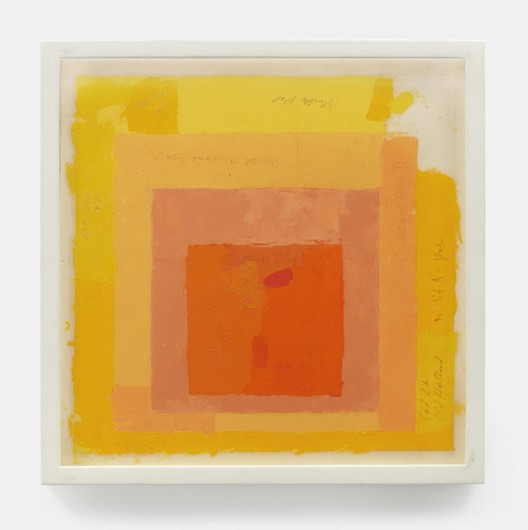
Color study for Homage to the Square, n.d., Oil and graphite on blotting paper, 13 x 13 x 1 1/4 inches (33 x 33 x 3.2 cm), © 2017 The Josef and Anni Albers Foundation/Artists Rights Society (ARS), New York. Courtesy David Zwirner, New York/London.

